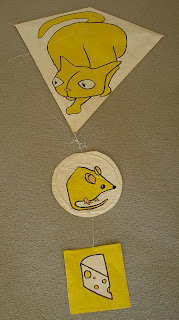I dropped out of blog reading for about a year while I reconnected my artistic roots. While I carefully grew back from kites to watercolors to graphite and now to acrylics... From pictures of things, to pictures with things, to pictures that have no things, I cut way back on reading.
Lately, though, as my own confidence as a creative person is reaching a new place, I have begun this blog of my own and started reaching out again to blogs I read in the past.
Breakfast with Pandora is one of those. I greatly admire its author's commitment to youth, and his daily work with teenagers. They're a tough crowd because there is so much energy, and I don't just mean hormones. Think of the power of the waters of Niagara, just as they roar out into the gorgeous arc of freefall... This is youth, poised to tackle adulthood.
I left DF (Breakfast's creator) a comment today, on his
Cassandra Kubinski post. I quote the comment here, too.
Go read this guy's work - it will change your view of life, of youth, of our ancient roots in Greece and myth.
And he has started a novel which he will post on-line for comment, as well. You should read his
post about the novel first.
COMMENT I WROTE:
OK - I'm seeing a strong pattern here as I read more of your aesthetic impressions and your own creative work. The way so many of Cassandra's pieces start with lovely simple piano and then her voice, lovely, young, vulnerable, present - all characteristics that are best set simply... Your comparison of Paris and Greece... There are two things that emerge to me.
First, you have a fascination for the essential, like earthy smells and tastes, life & death, eating, blood and pain, love, the feel of the ground under our feet.
It was my impression as a student of ancient Greek philosphy (at UNC-CH) that not only were Greek philosophers fascinated with the root ideas, but their very language was all tangled up with the most basic of things, and sounded like life itself. Hebrew strikes me in a similar way, as a language that is created from the sounds of earth and life and death, but both Hebrew and Greek go on to have enough superstructure to build religions, cosmologies, and metaphysics.
When I studied Latin I was overwhelmed with the cleverness, the intricate weave of the language, and particularly of the poetry, like the Aeneid. The same, it seems to me, could be said of French or Arabic. But Greek and Hebrew have gradually come into my view, like hills emerging across the valley as the mist clears later in this day that is my life, as the older and more essential places.
So I'm not surprised to see you spend so much creative energy on things Greek and Proto-Greek - regardless of your abiding love of Latin, and your daily work with it.
Second, your passion and compassion for youth. Cassandra's sound, face, themes, are all young. It's not innocence that draws you, though, I think - because it's not children you seem primarily drawn to, but the transition to adult awareness while the possibilities and desires still remain boundless. The conviction that power is limitless. The Israeli's are purported to draw their fighter pilots (the most daring in the world) solely from adolescents because so many 17 year olds believe they are immortal.
So it's not innocence, but something else that is still intact in youth. Infinite horizons. The same sort of view of the world and life that makes us godlike, creative, confident, open. Of course we inevitably discover our limitations and must overcome that realization - that is one way of defining coming of age... There is an intoxicating beauty in the young man or young woman poised on the brink of that journey, and your daily work and your creative work are planted on that edge, where you can watch, listen, and help.
I plan to order her CD. Adult artists (Paul Klee and Alexander Calder, among others) sometimes remark that their art is an attempt to learn again how to draw as children. My artistic journey is like that, too. And from that place on the road, it is possible to look backwards and forwards to the lovely work of artists like Cassandra.
 So in Ashland, KY (see January posts) in the early morning, with snow falling outside my hotel room window, I was struck by the arrangement of my keys, comb, and pen on the desk. I wish I hadn't cartooned the left portion of the comb, but I'm pleased with this sketch. I have not been one who doodled or sketched all the time, but this could be habit forming.
So in Ashland, KY (see January posts) in the early morning, with snow falling outside my hotel room window, I was struck by the arrangement of my keys, comb, and pen on the desk. I wish I hadn't cartooned the left portion of the comb, but I'm pleased with this sketch. I have not been one who doodled or sketched all the time, but this could be habit forming. A few weeks later the cats and sun posed. Actually the male (Tamlin, on the right) moved midway through drawing him, so his pose combines several moments. And he left completely before I could finish. I really like to draw them, and I'm mesmerized by their movements, particularly Tamlin's - the muscles and bones moving beneath his ginger striped fur. So alive and languid, like an athlete after a massage and a hot soak.
A few weeks later the cats and sun posed. Actually the male (Tamlin, on the right) moved midway through drawing him, so his pose combines several moments. And he left completely before I could finish. I really like to draw them, and I'm mesmerized by their movements, particularly Tamlin's - the muscles and bones moving beneath his ginger striped fur. So alive and languid, like an athlete after a massage and a hot soak.

















